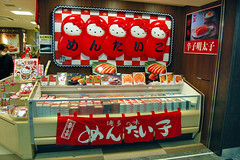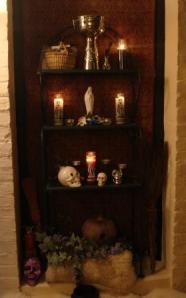Urban Dictionary describes Hello Kitty as a "Japanese mass-casualty weapon... Doctors warn that even low-level exposure may cause a perfectly sound mind to crack."
But is Hello Kitty truly evil?
There are plenty of conspiracies connected to the Hello Kitty phenomena. But that doesn't mean that the concept is one of evil.
This is the iconic white cat with the red bow, dots for eyes, and absent mouth that is mysteriously cute as hell to little girls.
This is the iconic white cat with the red bow, dots for eyes, and absent mouth that is mysteriously cute as hell to little girls.
The absence of a mouth makes her a little creepy. There are urban legends that state the mouth was left of because she was first drawn by a child suffering abuse, who wanted someone to confide in. There is also a legend that states she was drawn by a mother who's daughter was dying of cancer, and that the little white cat is a the result of a pack she made with the Devil to cure her daughter - the mouth was left off so the character could never spill the beans to anyone.
| Hello Kitty Mentaiko? (Photo credit: jpellgen) |
A little History on Kittty...
Hello Kitty first came into being in the 70′s when a then new company called Sanrio needed to come up with a merchandise mascot that would appeal to the pre-teen girl demographic. They commissioned an artist to work on the project and she came up with a drawing of a white Japanese Bobtail cat that had a red bow in it’s hair and was wearing blue overalls.
A whole back story for Hello Kitty was created, which is basically this: Hello Kitty is actually a nickname for Kitty White, who is not Japanese but actually British and lives in London with her family.
The Hello Kitty character was deliberately designed without a mouth so the lack of that visual cue made it easier for people to project their own feelings on to the cartoon character.
However...
Their is something fundamentally wrong with a mute character that pre-teen girls can project their own emotion onto with impunity.
If nothing else, this little symbol of girlie cuteness has more of the Japanese Goth about it than British teen. It has seduced a world of females and has made its creators billionaires. (There are even theme parks and beauty products with the white bobtail cat's insignia on them.)
Hello Kitty has reached cult status with many fans - so now is close to becoming a religious icon. If someone truly sold their soul for this phenomena, it was quite a deal, and one that just keep on growing.
Is Hello Kitty Evil? Who knows?...
Personally, I can't stand the thing and find it completely creepy. But what do you think?

The VuDooMan is in the House
When you need a little faith, turn to the VuDooMan
















